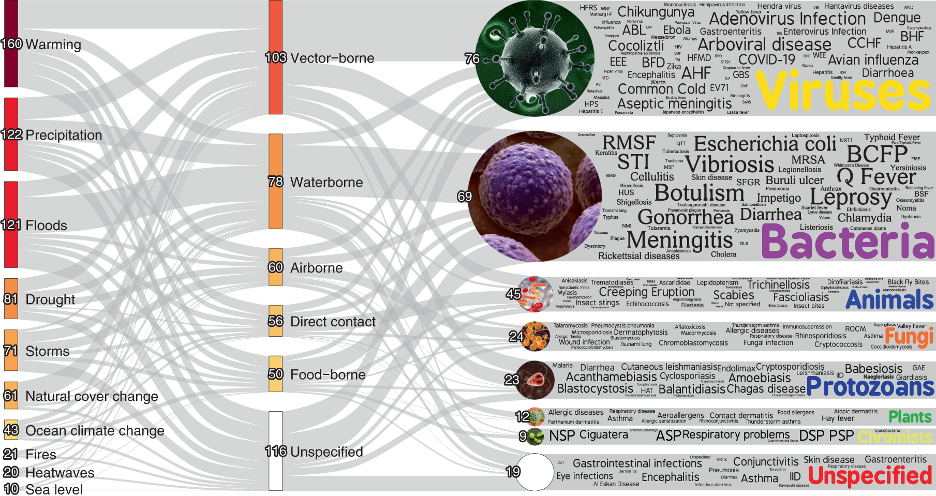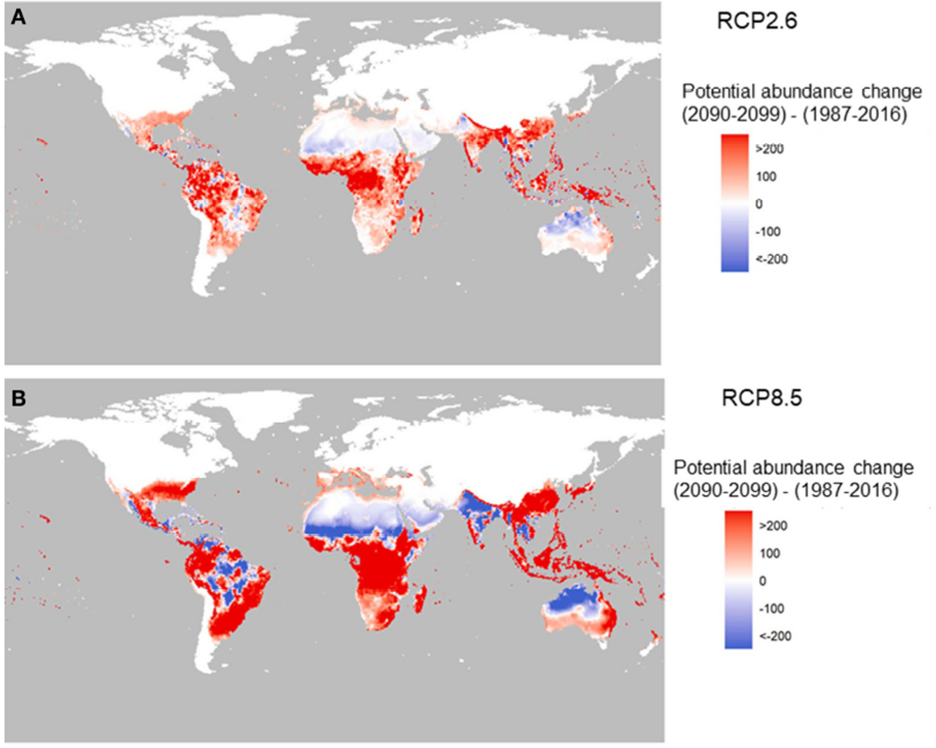Energy Innovation partners with the independent nonprofit Aspen Global Change Institute (AGCI) to provide climate and energy research updates. The research synopsis below comes from AGCI Program Director Emily Jack-Scott and a full list of AGCI’s updates covering recent climate change and clean energy pathways research is available online at https://www.agci.org/solutions/quarterly-research-reviews.
A new analysis by Camilo Mora and colleagues published in Nature Climate Change snagged headlines this summer by outlining a staggering 1,000 pathways through which climate change exacerbates diseases in humans. Among the projections: climate impacts worsen nearly 60 percent of infectious diseases. The research underscores a trend that scholars have warned of for decades: climate change presents new and intensified challenges for human health.
Experts are urging decision-makers headed to COP27 to center human health in this year’s discussions about climate change mitigation and adaptation. It’s critical for COP27 representatives—and public health institutions more broadly—to prepare for not only the threat of climate-driven upticks in disease but also decreased nutritional value of foods and supply-chain disruptions caused by our changing climate.

Extreme events cause immediate devastation and disease
Anthropogenic climate change is making extreme events (such as hurricanes, droughts, and floods) more frequent and intense, with immediate impacts on human physical and mental health due to loss of life, injury, and displacement. These extreme events have similarly catastrophic consequences for croplands and drinking water supplies, leaving many people unable to find food or potable water.
As Jan C. Semenza and colleagues explain in a recent article in Infectious Diseases and Therapy, extreme events like hurricanes and flooding often have secondary waves that compound the initial devastation in the form of waterborne and foodborne illnesses. More frequent and more intense storms create land runoff that can overwhelm water treatment facilities, contaminating drinking water with hazardous waste or soils with intestinal parasites.
Without immediate control measures in place, diarrhea and intestinal illness can then become self-perpetuating, with affected individuals reinfecting those around them. Contaminated water can also end up on crops, which if not cleaned and prepared carefully (often not possible in the wake of a storm), can lead to further cascading effects on human health. Low-income communities and countries with insufficient or outdated infrastructure are especially vulnerable to these reinfection cycles in a changing climate.
Rising temperatures create conditions for new and more numerous pests and vectors
Semenza and colleagues note that it’s not only punctuated extreme events that threaten health. Long-term impacts of climate change, such as increased average temperatures and changes in frequency and duration of precipitation, also create conditions in which pests and pathogens flourish.
As global temperatures rise, notorious disease vectors like mosquitos and ticks can stay active for more months of the year. Their habitable ranges also expand as winters become milder in mid-latitude locations. Tropical Aedes aegypti mosquitos, for instance—a primary vector for malaria, dengue, chikungunya, and Zika virus—are now present in the southeast U.S. Control measures are being adapted to reduce mosquito breeding grounds and slow the proliferation of such diseases. But as Semenza and colleagues illustrate, the extent to which vectors like A. aegypti continue to spread will depend in large measure on how quickly we mitigate climate change and curb emissions (see Figure 2).

The same is true for pests and pathogens that affect crop health. For instance, a warming climate creates more hospitable conditions for some pathogens, such as Escherichia coli (E. coli), to proliferate on produce and other foods. As noted at a 2019 workshop hosted by the Aspen Global Change Institute, increased temperatures and shifting precipitation patterns contribute to a host of changes in both agricultural and aquacultural pest and pathogen populations. According to an article in Science written by some of the workshop participants, among the staple crops of rice, maize, and wheat, yield losses due to pests alone are projected to increase 10 to 25 percent per degree Celsius of average warming. As in the case of human diseases, the range of potential crop losses underscores the immense premium of each degree of warming that can be prevented through climate mitigation.
More CO2 in the atmosphere can decrease crop nutritional content
In addition to compromising plant health due to pests and pathogens, emerging research shows that climate change may diminish the nutritional value of the foods we eat. Researchers are still working to understand the complex ways higher temperatures and CO2 concentrations impact crop growth. Higher CO2 levels may in fact increase crop growth, up to a point—but that doesn’t translate into more nutritious food.
As Kristie L. Ebi and colleagues show in their 2021 piece in Environmental Research Letters, the nutritional quality (including protein, certain vitamins, and micronutrients) of crops like wheat, rice, barley, potatoes, and oats can be compromised by rising CO2 concentrations. The implications for human health are huge. Each of these staples has an outsized role in the food system—wheat alone accounts for 20 percent of world protein consumption—so any decline in their nutritional concentration is significant. Furthermore, elevated CO2 concentrations can result in greater uptake and concentration of soil toxins (such as arsenic or cadmium) in rice. As with the impact of extreme events on human and plant pests and pathogens, reduced nutritional content in crops will have especially pronounced consequences for those living in low- and middle-income countries.
Global supply chains are susceptible to climate change impacts
Healthy diets are the foundation of resilient immune systems. As human disease loads increase, it will be even more important to build and maintain resilient agricultural systems, even though they, too, are threatened by climate change impacts. Other critical elements in this equation are access to and distribution of foods through robust supply chains.
Arunima Malik and colleagues recently modeled in Nature Food the indirect impacts of extreme events on supply chains and found that such events can cause food prices to skyrocket and food quality to diminish. These impacts play out on local to global scales due to the interconnectedness of the world’s supply chains. Fresh produce and meats are especially susceptible to price shocks. When prices rise, many consumers end up eating processed or preserved foods with longer shelf lives, which often have lower nutritional value.
This phenomenon is unfolding not in a gradual progression but rather in fits and starts, presenting critical supply-chain considerations, especially when it comes to nutritious, fresh produce. Most affected will be impoverished or rural communities without financial means or ready access to navigate supply-chain disruptions. Sustained malnutrition can have cascading and intergenerational repercussions.
Public health and climate professionals must combine forces
Climate impacts vary by region, just as health systems vary dramatically depending on local populations, politics, and governance. As Paul J. Edelson and colleagues discuss in their article in Clinical Infectious Diseases, there is an urgent need to invest in collaboration and infrastructure to prepare communities for the cascading human health impacts already starting to unfold. Interventions will need to be designed for local cultural and socioeconomic conditions, but decision-makers must also integrate responses within national and international frameworks, since shocks in one region can trigger significant shocks the world over.
While the knowledge that a changing climate disrupts interrelated systems can be daunting, research tools are emerging to help understand these shocks and respond accordingly. As one example, the World Health Organization has issued guidance for how communities can design water safety plans that incorporate climate change information. This guidance showcases tactics that water managers can use to diminish water quality risks that are directly and indirectly responsible for illness from contaminated waters. For example, managers can adapt storage systems to keep water cooler or adjust disinfection protocols to reduce pathogens and by-products. Farmers can be incentivized to change the way they apply fertilizers to minimize runoff near key catchment areas.
Ebi and colleagues also discuss opportunities for researchers to examine feasible options to address nutrient deficiencies in crops. For example, fortified foods and supplemental nutrients have long played a role in processing cereals and grains (adding iron, for instance, to lessen amenia). Similarly, leveraging the genetic diversity of crops through conventional crop breeding and genetic modification may prove cost effective. Getting the solutions right relies in part on addressing current data gaps, since data is disproportionately collected in high-income countries rather than in low- and middle-income countries, which experience outsized impacts.
Featured Research
Curtis A. Deutsch et al., “Increase in Crop Losses to Insect Pests in a Warming Climate,” Science 361, no. 6405 (2018): 916-919.
Kristie L. Ebi et al., “Nutritional Quality of Crops in a High CO2 World: An Agenda for Research and Technology Development,” Environmental Research Letters 16, no. 6 (2021): 64045.
Paul J. Edelson et al., “Climate Change and the Epidemiology of Infectious Diseases in the United States,” Clinical Infectious Diseases (2022).
Arunima Malik et al., “Impacts of Climate Change and Extreme Weather on Food Supply Chains Cascade Across Sectors and Regions in Australia,” Nature Food 3 (2022): 631-643.
Camilo Mora et al., “Over Half of Known Human Pathogenic Diseases Can Be Aggravated by Climate Change,” Nature Climate Change 12 (2022): 869-875.
Jan C. Semenza, Joacim Rocklöv, and Kristie L. Ebi, “Climate Change and Cascading Risks from Infectious Disease,” Infectious Diseases and Therapy 11 no. 4 (2022): 1371-1390.
World Health Organization, Climate-Resilient Water Safety Plans: Managing Health Risks Associated with Climate Variability and Change (2017).